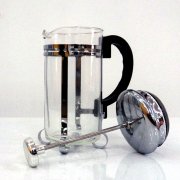International coffee quality appraisers teach you how to grade coffee.
On January 14, the third Pu'er Coffee Raw Bean Competition kicked off in Pu'er, Yunnan Province. the judges were 20 international coffee quality appraisers (Q-Grader) recognized by the American Coffee quality Research Institute (CQI). From January 14 to 25, they will test and grade 62 boutique coffee beans from all over Yunnan in strict accordance with the standards of the SCAA (American Fine Coffee Association) cup system.
Lao he, the coffee quality appraiser of the original cafe in Nan'an District, Chongqing, became the only one from Chongqing who was invited to serve as a judge. In September last year, he successfully passed SCAA's CQI (Coffee quality Research Institute) International Coffee quality appraiser (Q-Grader) qualification examination.
What is the special talent of coffee tasters? How can a cup of coffee be quantified into a standard? Lao he revealed the secrets for you one by one.
Drink hundreds of cups of coffee every day
According to the arrangement of the organizing committee, the judges will drink six to eight rounds of single coffee (pure coffee made from coffee beans without milk sugar) every day, and there will be six to eight groups of coffee in each round, with each group drinking five cups. Each cup of coffee needs to be tasted at least five times. In this way, Lao he will drink hundreds of cups of coffee a day.
Lao he said that drinking five times a cup of coffee is to experience the taste of coffee at different temperatures. Coffee tends to exert its aroma to the extreme at high temperatures, but its performance at low temperatures is more telling. For example, the sour taste of coffee may increase as the temperature decreases, so this method of coffee identification will be more comprehensive.
Smell, sip, meditate, score, smell, sip, meditate, score again. This is also the standard evaluation process for the jury to cycle N times a day.
These processes will eventually be translated into actual scores. Lao he told reporters that the SCAA Cup system has a set of scoring methods for aroma, flavor, aftertaste, acidity, balance, cleanliness, sweetness and so on, and finally summarizes the total score.
It takes half a year to build a fragrance map
Two years ago, Lao he, who loved coffee, opened a cafe and prepared for it for a year before taking the qualification exam for an international coffee quality appraiser in September last year.
Lao he said that he applied for a coffee quality appraiser, and the qualification exam was divided into two parts: six-day training and three-day formal examination. In order to complete this exam with a pass rate of only 50%, six days of training is far from enough. The most difficult items, such as the incense test, need to be accumulated in advance.
Lao he said that after the real high-quality coffee is prepared, it will give off a unique flavor and fragrance. For example, coffee in some areas has unique aromas such as flowers, fruits, spices, and so on. To taste these unique flavors, you need to establish your own fragrance map like a perfume appraiser to understand the characteristics of various fragrances.
To this end, Lao he spent nearly half a year buying a variety of flavor bottles, in-depth understanding of each flavor, slowly, Lao he can feel the subtle aroma of coffee only by smelling coffee. Lao he did not sign up for reference until he was proficient in the fragrance and cup tasting process.
How difficult are the formal examination items?
After arriving in Guangzhou, where the exam took place, Lao he not only attended the basic knowledge training, but also learned to grade the coffee together with the invited SCAA coffee instructor. After giving the score, the coffee instructor will tell the reasons for the evaluation, and the students will compare the self-scoring with the smaller the error, the better.
According to Lao he, the SCAA cup product system is standard, with a full score of 100. a comprehensive score of more than 90 points is considered outstanding coffee. Such coffee may have 8 to 9 different flavors, and the output will be very small. For example, in Panama, there are top coffee that can sell for thousands of yuan per kilogram, and 80 points can be regarded as boutique coffee.
The final 3-day exam includes 22 different items, such as smelling incense, cup test, triangle cup test and so on. The cup test is also divided into Chinese and American producing areas, Asian producing areas and East African producing areas. There will be a lot of interference during the exam, for example, three different cups of coffee will be served at the same time in the triangle cup test in the same producing area, of which two cups are the same and one cup is different, which requires that the trainees' characteristics and taste ability of the coffee from the origin reach a considerable level before it is possible to complete the test.
How to taste coffee professionally
Yesterday, Lao he also revealed the general method of tasting coffee to the reporter of Chongqing Evening News. Lao he also said that these methods are accurate to specific figures, and ordinary coffee lovers only need to be able to roughly judge.
1. 8.25g ground coffee with dry fragrance, put it in 3 to 5 sample cups and smell it carefully. The dry fragrance indicates the freshness of the coffee.
2. Wet fragrance add 93 ℃ fresh boiled water of 150ml to the coffee powder, soak for 3 to 5 minutes, then smell it carefully. The fruit and spice flavor in the coffee will be felt at this stage. Generally speaking, the wet aroma of coffee is related to the producing area, variety and growing environment.
3. Take 6 to 8 milliliters of coffee with a silver-plated spoon that helps to dissipate heat quickly and inhale it hard and quickly so that it is evenly distributed on the surface of the tongue. Different areas of the tongue can capture the different characteristics of coffee, such as acidic coffee can produce a tingling on the tip of the tongue.
4. the steam step is carried out at the same time as the previous step. After adding hot water, part of the organic matter changes from liquid to gaseous state, which helps to identify the smell.
5. Huiyun will first contain the coffee for a few seconds, then swallow a small part, and then quickly send the water vapor left in the back palate into the nasal cavity. At this stage, you can feel the mixed aroma of various compounds, such as chocolate, clove, turpentine and so on.
6, mellowness is the final evaluation of the taste, the tongue gently across the mouth palate, through the feeling of oily, smooth degree, feel the mellowness of coffee, such as fiber, protein content and so on.
Characteristics of individual Coffee in different regions
Coffee from different producing areas also has some obvious characteristics, which were also revealed by Lao he yesterday.
Colombian coffee: stable quality and flavor, coffee soft and mellow; with slight acid to medium acid, suitable for the preparation of comprehensive coffee.
Brazilian coffee: slightly sour, slightly bitter, mild, is the representative of neutral coffee.
Italian coffee: coffee has a strong aroma and bitter taste, and a thin layer of coffee oil often appears on the surface.
Blue Mountain Coffee: coffee beans produced in the Blue Mountains of Jamaica above 2500 feet above sea level, supple, sweet, slightly sour, delicate flavor.
Manning coffee: produced in Indonesia, the flavor is fragrant, strong, bitter, the taste is quite strong, but supple without acid.
Important Notice :
前街咖啡 FrontStreet Coffee has moved to new addredd:
FrontStreet Coffee Address: 315,Donghua East Road,GuangZhou
Tel:020 38364473
- Prev

The method of pressing pot and brewing coffee suitable for lazy people
The French filter kettle is not only the most convenient household coffee pot, but also the best way to retain the flavor of coffee. The French press can perfectly show the charming and mellow flavor of deep-cultured coffee. Its structure is simple, but it has many advantages. The French kettle is very suitable for lazy people. Its production principle is that it is soaked and stewed in full contact with coffee powder.
- Next

Can I have coffee with a cold?
Can I have coffee with a cold? A cold is not allowed to drink coffee, coffee contains caffeine is not conducive to the recovery of patients with colds, see that you can adjust your diet, you can drink more water, regularly to the hospital to give review treatment, you need to pay attention to keep warm, diet to enter some easily digestible soft food, eat more fruits and vegetables, avoid spicy and stimulating diet.
Related
- Beginners will see the "Coffee pull flower" guide!
- What is the difference between ice blog purified milk and ordinary milk coffee?
- Why is the Philippines the largest producer of crops in Liberia?
- For coffee extraction, should the fine powder be retained?
- How does extracted espresso fill pressed powder? How much strength does it take to press the powder?
- How to make jasmine cold extract coffee? Is the jasmine + latte good?
- Will this little toy really make the coffee taste better? How does Lily Drip affect coffee extraction?
- Will the action of slapping the filter cup also affect coffee extraction?
- What's the difference between powder-to-water ratio and powder-to-liquid ratio?
- What is the Ethiopian local species? What does it have to do with Heirloom native species?

